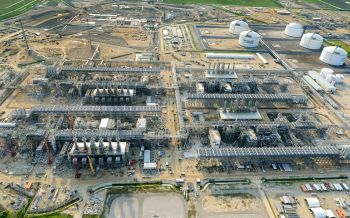Last year marked another record for the LNG industry, with global imports rising by a “vigorous” 13% to hit 354.7 million tonnes (mt) in 2019, according to the latest annual report from LNG importers’ association GIIGNL. But with the Covid-19 pandemic curbing global energy demand, disrupting supply chains, decimating capital expenditure budgets and delaying projects, doubts are growing around the degree to which that momentum will be sustained throughout 2020.
“2019 marked an all-time record increase in annual LNG production, driven by new liquefaction trains and ramp-ups in the United States, Russia and Australia,” GIIGNL president Jean-Marie Dauger said in the report, published this week.
“Over the last three years, the industry has added more than 80 mtpa of new capacity and significant volumes are due to come online by 2025. Besides, 2019 was a record year for new investment decisions, which reached 71 mtpa worldwide by the end of the year.”
He added: “In the near term, the disruptive impact of the Covid-19 outbreak on the economies of importing countries will exert downward pressure on LNG demand in an already oversupplied market.” The key question is by how much – and to what extent will LNG shut-ins be required to balance the market. GIIGNL, perhaps wisely, did not venture to address this.
Pre-coronavirus, some analysts were expecting LNG supply-demand growth in 2020 to be around 30 mt – with 21 mt coming from ramp-ups in capacity already in operation at the beginning of the year and about 9 mt from 2020 liquefaction start-ups.
Initial LNG flow data indicates that the impact of Covid-19 on natural gas demand has been less than feared. Ship tracking data compiled by Gas Strategies shows global supply reached 96.5 mt in Q1’20, an increase of 10% on the year-ago period.
During this time, LNG buyers in China and elsewhere have tried to declare force majeure on some contracts, while others have exercised downward quantity tolerance (DQT) clauses in term contracts. But the result has been merely a 4% year on year reduction in China’s Q1’20 LNG imports, to 14.5 mt.
Japan’s LNG imports also decreased by a marginal 2.6% to 21.4 mt in Q1’20, but this was more than offset by strong growth of imports into South Korea (4.2 mt, +23.5%), India (6.6 mt, +37%), Taiwan (4.2%, +34%), and Europe (28 mt, +33%), according to shipping data.
Extrapolated over the full calendar year, Q1’20 data suggests LNG trade flows in 2020 will hit 386 mt – representing year-on-year growth of 8.8%. But this fails to consider that projects that ramped up towards the end of 2019 will reach plateau in 2020.
Moreover, there are now emerging constraints to consumption in key Asian markets that grew markedly during Q1. South Korea's KOGAS this week reportedly requested Total and Petronas to defer some cargoes due to high storage levels and soft demand.
India, which opportunistically hoovered up cheap spot LNG cargoes throughout Q1’20, imposed a stringent lockdown at the end of March, prompting Petronet and other buyers to issue force majeure notices amid reports that ports were considering closing. A sharp reduction in Indian LNG imports will not show up until Q2’20 data is available, but it has already weighed heavily on the Asian LNG spot price.
In Pakistan, Qatargas last week agreed to reduce monthly LNG deliveries to state-run Pakistan State Oil (PSO) by 40% due to downstream demand disruption caused by Covid-19, apparently to avoid being served another force majeure notice.
And Japan, where demand is already falling, this week declared a state of emergency in response to a sharp rise in Covid-19 cases, giving prefectural governors authority to close non-essential businesses, reports indicate.
Supply-side fall guy?
Looking at project schedules, LNG supply is expected to reach 370 mt in 2020, a 4.3% increase on 2019. While LNG supply tends to drive demand, this assumes that the market always balances, typically by sending any surplus cargoes into Europe – the market of last resort which, so far, has prevented widespread liquefaction shut-ins in the US and elsewhere.
Only a handful of cargo cancellations have been confirmed by the likes of Cheniere Energy in the US, but every week seems to bring news of fresh force majeure claims on LNG purchase contracts as importing countries enforce lockdowns in a bid to stem contagion.
Cheniere’s marketing arm last week bought four spot LNG cargoes for delivery into Europe in May, stoking speculation that shut-ins at the Sabine Pass and/or Corpus Christi LNG plants on the US Gulf Coast are likely. However, that is not a given, as Cheniere Marketing is known to have the freedom to pursue market opportunities that deliver portfolio value, independently from Cheniere Energy’s obligations to its customers.
Meanwhile, there are signs that China is tentatively returning to the market, with four US LNG spot cargoes heading to Chinese ports from next month. China yesterday recorded its first day without any new Covid-19 infections since it started publishing daily figures in January, and lifted travel restrictions on Wuhan, the original epicentre of the outbreak.
No last resort
All eyes are now on Europe, where strict Covid-19 lockdowns remain in force across much of the continent, but infection rates seem to be peaking in heavily impacted Spain and Italy. With unseasonably high gas storage levels and lockdowns weighing on industrial demand, questions swirl around lockdown exit strategies – and the concurrent timeframe and pace of the anticipated economic recovery.
“With prices in Europe already at rock bottom, how much more gas can the markets absorb?” one industry source posited to Gas Matters Today. Pipeline flows are also down year-on-year at the moment, so “what happens if Russia open the taps? Storages are already pretty full!”
“Once growth markets are full and Europe can take no more LNG, then we may see a larger supply side response (via US shut ins),” the source added. While some shut-ins seem inevitable – two Cheniere customers have already cancelled April cargoes – there is a lively debate around the likely scale of supply-side adjustments required to balance the market.
For 2020 global supply output to fall below 2019 volumes, it would require Cheniere to shut in Sabine Pass entirely for the remainder of the year. While this might seem outlandish, “as much US production will shut in as is needed to balance the market – if that is all of Sabine Pass, why not?” another LNG expert commentator noted.
The only certainty is uncertainty at this stage of the global pandemic. Analysts are busy pushing out bullish and bearish forecasts for 2020 LNG market growth or contraction, but the situation is changing almost by the hour and little credence can be afforded to speculative views of the unknowable near-term future. What is clear is that 2020 will be remembered as a year of unparalleled disruption on every conceivable level that, among many things, marked the start of a new chapter in the evolution of the LNG market. - SK
Subscription Benefits
Our three titles – LNG Business Review, Gas Matters and Gas Matters Today – tackle the biggest questions on global developments and major industry trends through a mixture of news, profiles and analysis.
LNG Business Review
LNG Business Review seeks to discover new truths about today’s LNG industry. It strives to widen market players’ scope of reference by actively engaging with events, offering new perspectives while challenging existing ones, and never shying away from being a platform for debate.
Gas Matters
Gas Matters digs deep into the stories of today, keeping the challenges of tomorrow in its sights. Weekly features and interviews, informed by unrivalled in-house expertise, offer a fresh perspective on events as well as thoughtful, intelligent analysis that dares to challenge the status quo.
Gas Matters Today
Gas Matters Today cuts through the bluster of online news and views to offer trustworthy, informed perspectives on major events shaping the gas and LNG industries. This daily news service provides unparalleled insight by drawing on the collective knowledge of in-house reporters, specialist contributors and extensive archive to go beyond the headlines, making it essential reading for gas industry professionals.





